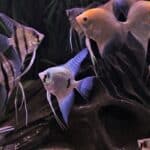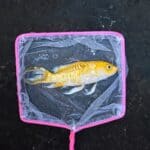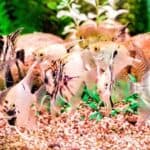When water evaporates from a fish tank, it isn’t replaced. Consequently, owners must regularly top the tank to prevent significant water loss that affects their fish’s health.
Most fish tanks experience at least ½ gallon of water loss a day.
You can top up the tank a couple of times a week with clean, purified water, but don’t do this too often as you’ll risk affecting the water conditions.
Instead, carry out a 10% water change every week or 25% every two weeks.
Keep the water cool and increase the room’s humidity to reduce evaporation. A lid will also make a difference, as will turning off the aquarium lights whenever possible.
Evaporation is a part of owning a fish tank, and not dealing with the problem causes issues. Ammonia will rise, and evaporation will decrease oxygen levels, endangering the lives of your pet fish.
Why Does Water Evaporate from A Fish Tank?
A small amount of evaporation is normal and can’t be entirely prevented. However, it’s possible to slow the process down if you’re aware of what causes it in the first place.
These factors speed up the process of evaporation:
Warm Water
The leading cause of evaporation is heat. Evaporation happens quicker when the water temperature increases. Heat causes water molecules to bounce around and collide, moving faster as the heat rises.
The molecules become energized, hitting each other harder and gaining more energy to transform from liquid to gas. At this point, the water evaporates from the tank.
Lack of Humidity
The lower the humidity of the air outside the tank, the faster evaporation occurs. Dry air is further away from saturation, allowing a greater level of evaporation to occur.
Similarly, if the air is warm, it holds more water vapor concentration, leaving more room for storing water vapor. As you’d expect, evaporation occurs faster in the summer when it’s warm.
Although dry conditions are also responsible for fast evaporation, regardless of the season.
Air Movement
As described by Sciencing, the speed at which air flows over the water’s surface affects the rate at which evaporation occurs. That’s because air movement across the surface carries rising water vapor away.
It also dries the air, making water evaporation easier. This will likely occur when aquarium keepers use fans to cool the water surface.
Moving Water Surface
Water agitation speeds up evaporation because the ripples across the water’s surface create a larger surface area, allowing the evaporation process to occur more quickly.
Air stones and Gyre pumps move more water across the tank, causing larger amounts of H2O to leave.

How Much Evaporation Is Normal for A Fish Tank?
Every aquarium’s evaporation levels differ due to size, water conditions, and room temperature. Also, you’ll experience more evaporation in the summer than in the winter.
A standard 50-gallon saltwater tank evaporates approximately ½ gallon of water per day. This means you must add 3.5 gallons of purified water every week.
A 50-gallon freshwater aquarium loses around a gallon of water each day.
Saltwater tanks evaporate slightly slower than freshwater aquariums because the water molecules use more energy to break the dissolved salt ions apart for the water to evaporate.
How To Add More Water To A Fish Tank
Replacing evaporated water involves adding water to the tank.
Simply topping up the aquarium after evaporation can harm your fish because pollutants like nitrate and phosphate accumulate.
The water’s alkalinity and pH are also likely to drop. Consequently, the fish will become stressed and more susceptible to diseases and infections.
To preserve the tank’s conditions, change 10% of the water in the aquarium every week or 25% every 2o weeks. A water change is beneficial for the following reasons:
- Removes waste.
- Prevents unwelcome growth.
- Helps your filter.
Adding more water to replace what’s evaporated occasionally is okay. Use the following methods:
Manually
When topping up the water, only use pure, demineralized water to prevent harmful chemicals from entering the tank and changing the conditions too much. This can put the fish under too much stress.
If you don’t have access to pure water, you must make tap water safe before adding it to your tank.
Some owners pour purified water straight into the tank through a bucket or jug. Unfortunately, this usually leads to sudden changes within the tank, wreaking havoc on the aquarium’s ecosystem.
To safely add the water to the tank, store it at room temperature for a few days before pouring it in.
Automatically
An easier way to top up your tank’s water levels is to use a semi-automated dosing pump. They’re designed to pump small amounts of water into the tank, ensuring the water levels don’t drop too low.
The benefit of a dosing pump is it prevents mistakes and stops you from forgetting to top up your tank.
How Far To Fill Up A Fish Tank
To work out how much water you need to add to your tank after evaporation, fill the aquarium up to your desired level and mark the glass with a pen or piece of tape.
You can then use this to calculate how much water you need to replace every week. To do this:
- After a week, measure the distance (in centimeters) between the current water level and the one you’ve marked up.
- Multiply this value with the width and length of your aquarium.
- The calculation will give you the amount of water evaporated in milliliters in 1 week.
- Divide this number by seven. This will give you your daily water loss number.
However, you must re-calculate this number when the seasons change, as you’ll lose more water in the summer when it’s warm and dry.
If you haven’t got time to work this calculation out or need a quick answer, subtract 1% of the water’s temperature for an approximate daily evaporation estimation.
How To Stop Aquarium Evaporation
You can’t stop aquarium evaporation, but you can slow the process down with these methods:
Regulate Water Temperature
According to Environmental Science Investigation, fish can’t regulate their body temperature and rely on the water being in the right conditions to survive.
Too much heat causes evaporation and speeds up fish’s metabolism, causing toxins to rise in the tank.
While tropical fish species thrive in warmer temperatures, they can tolerate a small heat range, meaning you can keep the water at the cooler end to prevent evaporation.
Fish also get stressed if the water’s too warm, so monitor the temperature to ensure it doesn’t rise unexpectedly. This would increase the amount of water evaporating and negatively affect the fish.
Maintain Room Temperature
To prevent the water from evaporating too fast, ensure the room you house your aquarium in remains as cool as possible without being too cold. This will prevent evaporation from occurring as quickly.
Evaporation speeds up when the air is dry, so maintaining humidity in the room should help.
Ensure the tank is located away from sunny windows. If the room lets in too much light, place a cover over the tank for a couple of hours and consider putting the tank somewhere cooler and darker.
Use A Lid
Adding a glass lid to the aquarium makes it harder for evaporation to occur.
Also, the water condenses on the lid’s inside and drips back into the aquarium, slowing the evaporation rate. This emulates the natural process of rain dropping down to the ground from clouds.
Using a glass or plastic lid has other benefits, as it helps maintain the water temperature and prevents fish from jumping out of the tank. A cover also prevents items from falling into the tank.
Choose Your Fish Wisely
While choosing fish based on appearance is tempting, this isn’t the best way to create a community.
If you live in a warm, dry climate, you’re better off choosing fish that prefer inhabiting cooler waters, like goldfish. Other fish that can tolerate cooler water include:
- Bloodfin tetra.
- Rosy barb.
- Buenos Aires tetra.
- Pearl Danio.
- Zebra danio.
These fish survive in temperatures around the mid-60s (Fahrenheit), meaning you can safely keep the outer environment at room temperature without affecting the fish.
Change The Water Filter
Old, clogged-up filters will attempt to work, even if malfunctioning.
The filter will then get excessively hot and warm up the water. Not only will this cause evaporation, but it could burn your fish if they get too close.
If unclogging the filter doesn’t solve the problem, get a better one to see if it helps.
Turn Off The Lights
Lights generate heat, which causes evaporation.
At night, turn off all aquarium lights. As well as helping with your evaporation problem, this will enable your fish to get a good night’s sleep.
Fish are diurnal animals, so they sleep like we do at night when it’s dark. Before bed, switch off the aquarium lights and pop them back on again in the morning.
If the lights get excessively warm during the day, switch to high-efficiency, low-energy bulbs that provide enough light but don’t give off too much heat.
If you use a lighting system to heat the tank, turn down the heater to conserve electricity.
Test The Water
To prevent excessive evaporation, regularly test the water temperature using a thermometer. Sometimes, the water temperature rises without warning, meaning it’s almost impossible to monitor visually.
Some thermometers clip directly onto the tank, while others take the temperature from the inside. The most accurate thermometers come with a probe, allowing you to test the water rather than the glass.
Reduce Your Tank Size
Wider tanks experience more evaporation because they have a larger surface area.
If this is causing a problem and the fish suffer because you can’t control the tank’s dwindling water supply, you might be better off switching to a smaller tank and reducing the number of fish.
The fish will become sick if you allow harmful ammonia and nitrites to rise. Similarly, as explained, topping up the water every day isn’t a viable long-term solution.
Problems Caused by Water Tank Evaporation
While evaporation is part of owning a fish tank, it can cause problems that affect the fish’s health and well-being. Evaporation doesn’t always seem significant, but it’s responsible for:
Rising Ammonia Levels
Evaporation leaves less water in the tank, increasing the amount of ammonia. Evaporated water also leaves the nitrite and ammonia particles created by the fish’s waste.
This isn’t a huge problem in small quantities, but the tank’s conditions become unsanitary if the evaporated water isn’t replaced quickly enough.
Fish are sensitive to ammonia. If exposed to it for too long, they’ll be poisoned by the toxicity.
The signs of high ammonia levels include:
- A foul odor that smells similar to urine.
- Fish gasping at the surface in an attempt to find air.
- Motionless fish who stop swimming.
- Appetite loss.
- Red or cloudy eyes from the burns.
- Redness around the fish’s gills.
Water changes should prevent ammonia from becoming a problem after evaporating.
Increased Salinity
In saltwater tanks, water evaporation leaves behind salts and minerals.
Consequently, the tank’s salinity increases, causing problems for the fish. Too much salt dehydrates fish and causes their scales to go slimy. In the worst cases, the fish will die.
Automatic top-off systems benefit saltwater tanks, as they keep the salinity levels consistent.

Low Oxygen Levels
Evaporation lowers the tank’s oxygen levels. This is a problem as fish need dissolved oxygen to breathe.
Unfortunately, it’s not always easy to tell that there’s not enough oxygen until it’s too late, but paying attention to the most common signs means you can monitor the levels.
The symptoms of insufficient oxygen include:
- Fish gasping at the surface for air.
- Lethargic, non-moving fish.
- Lack of appetite.
- Labored breathing is observed through the rapid closing and opening of the gills.
As well as adding more water into the tank, increase oxygen levels by adding more plants, providing a suitable substrate, and decreasing the number of fish.
Increasing the aquarium’s surface area and aeration can also help, but they’ll likely speed up the rate at which evaporation occurs.
Stressed Fish
Even the most minor environmental changes can stress your fish.
If evaporation occurs too quickly and the water isn’t topped up, the fish will have less swimming space. This creates overcrowding, and symptoms of stress will occur. These include:
- Increased aggression.
- Frantic swimming.
- Hiding away for long periods.
- Surfing the glass.
- Changing appearance, such as dimmer colors.
- Diseases and illnesses.
Improper water conditions are among the leading causes of stress.
Even if one factor is off, the fish could suffer. As explained, suboptimal salt levels in a saltwater tank, rising ammonia, and changing pH levels will raise stress levels.
Therefore, you must keep on top of your tank’s evaporation levels.








